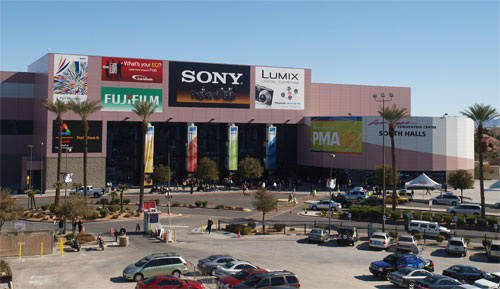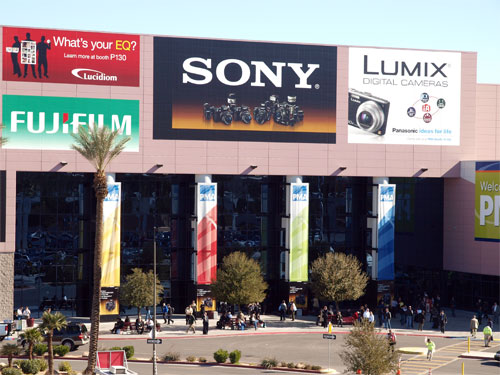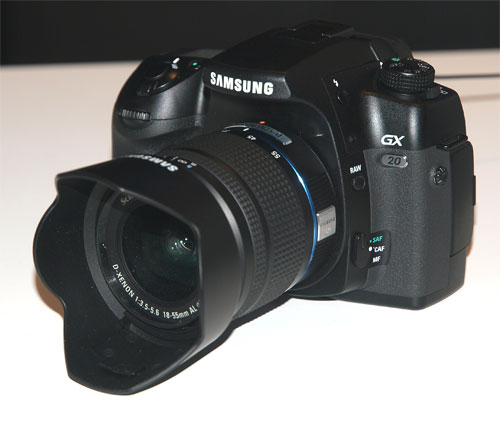The 84th Annual PMA kicked off in Las Vegas on Thursday. PMA bills itself as “The Worldwide Community of Imaging Associations”, and if it has to do with imaging you will find it on display at PMA. The event is usually a late February or early March event, but this years scheduling placed it just a few weeks after CES. The other major photo event, Photokina in Hanover, Germany, happens every two years. 2008 is a Photokina year, so some major announcements will likely wait for that show this fall.


Around 20,000 attendees are expected to visit the halls of the Las Vegas Convention Center, and every digital camera maker is represented here this year. Like CES, many early announcements appeared from major names in the industry, presumably so they don’t get lost in the volume of PMA coverage. Canon announced their 12.2 megapixel XSi last week, which replaces the current XTi.



Pentax also introduced their 14 6 megapixel K20D in the week before the PMA show. The K20D also marked the introduction of a 14.6 megapixel sensor jointly developed with Samsung and manufactured by Samsung.

Samsung has been marketing their own versions of Pentax cameras for the past couple of years, so it was no surprise to see they will be marketing their own version of the Pentax K20D called the GX20. Features and specifications appear all but identical to the Pentax K20D.

Despite the early announcements there were still more introductions as PMA kicked off – and a few surprises in the digital camera arena.










22 Comments
View All Comments
Wesley Fink - Saturday, February 2, 2008 - link
PMA originally was an acronym for the Photographic Manufacturers Association, but it has lost that meaning over time as photography has shifted to imaging and PMA never makes mention of what PMA stands for any more. I defined PMA in some recent blog articles referring to the show.The second sentence in the article is 'PMA bills itself as “The Worldwide Community of Imaging Associations” '. This was mentioned at the beginning of the article to explain what PMA was about. With the introductory paragraph was it not clear that PMA was a show of imaging solutions, which included digital phtography?
Per Hansson - Saturday, February 2, 2008 - link
Thank you Wesley Fink for your work with this article, but I have a small grip with the Sony Live View system"The Sony Live View is clearly the best implementation of that feature on any SLR."
Well, like always lets take into account how it's going to be used
The Live View might be better for people coming from P&S cameras but it's surley not the holy grail
Canon's XSI with it's WYSIWYG Live View has it's own advantages, here is a small article on it (including downsides to the Sony design)
http://photoclubalpha.com/2008/01/31/how-the-live-...">http://photoclubalpha.com/2008/01/31/how-the-live-...
Also, on page X there are spelling mistakes, "certaihly" and "showss"
Johnmcl7 - Sunday, February 3, 2008 - link
I think you're quite right, the comments about liveview in the article seem to misunderstand the concept. This form of liveview thinking was certainly popular when only Olympus had it but funnily enough times have changed now that various other companies have it and people have realised the benefits.Without the facility to use the main sensor for liveview I think it leaves the Sony implementation still half baked - while the main sensor means delays with mirror flips it can be used for very accurate manual focus and generally works better in low light. In most cases when using the camera in liveview mode it's because it's in an awkward position so speed isn't really that useful. However as in these cases for me at least it's often macro having a 10x boost is very useful. While I could be lying along the ground to use the optical viewfinder, obviously it's far more comfortable to use the screen.
I have to say I remain uncovinced with the AT camera articles as they seem to consider the cameras far too much from a feature aspect without properly considering their usage. Furthermore I'm disappointed at the errors, the last camera comparison had numerous errors on 4/3 aspects alone and similarly there are errors in this article as well. As I'm only particularly familiar with the 4/3 system, I don't really trust what I'm reading on other cameras here.
John
Wesley Fink - Saturday, February 2, 2008 - link
I personally think Live View is very over-rated and is more a check list feature - even though I'm a fan generally of Olympus' recent 4/3 gear and Olympus invented Live View on the SLR. I spent a great deal of time at PMA walking around the show with A Sony A350 and I found the live view on their camera VERY fast and much more useful than I expected.The down side is Sony uses a tilting Penta-mirror, which means the way they do it will not work on more expensive SLRs with full optical viewfinders like the A700. The tilting Pentamirror is by definition an entry level solution for the DSLR. However, Sony sees it as a bridge technology for buyers coming from P&S and they feel strongly it should be just as fast as optical to be of any real value. I mentioned the Canon because I do believe as done on the upcoming XSi it is the next best solution for Live View, though it the Canon approach does have a different set of limitations.
SlinkyDink - Saturday, February 2, 2008 - link
I've been a fan of Anandtech since the geocities daysThis is the first article I've read here while, and felt a bit clueless in regards to the content. A camera lens thing? Whats it do? What do all these unfamiliar acronyms mean? Nikon didn't want a blower thing, but now they're adding one? I must have missed that news on cameraworld.com
If the content is going to stray away from the usual 'hardware analysis and news', then I think it should have bits of the article geared towards someone new to the topic.
Wesley Fink - Saturday, February 2, 2008 - link
If you clock on the 'Digital Cameras' tab at the top of the page you will find an article called "Digital Photography from 20,000 feet". I have mentioned in many recent reviews that you should start there if you feel lost in the terminology and concepts. As one comment pointed out nothing I said here was that unusual for those into Photography - even a little bit.There is also a late December Buyers Guides that talsk about features of all the models available before this show - and the article links the recent blogs on the introduction of the Canon XSi and the Pentax K20D.
AndyKH - Saturday, February 2, 2008 - link
If you want an introduction to the subject you could take a look on dpreview.com, a really excellent photo site.Bruce 1337 - Saturday, February 2, 2008 - link
Heh, yeah camera news can get a bit acronym heavy. I don't think anything mentioned would be unfamiliar to anyone "into" photography though, so I'm not sure how much they should be expected to define or explain ahead of time. They don't usually spell out stuff like Front Side Bus when talking about new PCs either. It's just assumed that the reader knows what terms like FSB, L2 cache, 45 nm, and SLI mean.But I think maybe an article explaining some of the basics would be helpful. Then they could link to it whenever there's camera news.
Briefly: the Nikon thing was talking about a sensor cleaning system that removes dust from the image sensor. SLR type cameras have the sensor sitting out in the air when you swap lenses, so they can get dirty. The VR lens has image stabilization so you get fewer blurry pictures when shooting in low light and such (very useful). Canon and Nikon have the stabilization take place in their lenses, whereas Sony, Olympus et al do it inside the camera body. The Live View stuff is confusing, but basically Sony's is the best. DSLRs didn't used to show you what you're taking a picture of in the LCD (you had to look in the viewfinder, for technical reasons). New DSLRs allow you to look at the LCD, but most can't autofocus and such while you're looking at the screen. Sony's is cool like that.
MrX8503 - Saturday, February 2, 2008 - link
Seems like all consumers can think about is Megapixel that, megapixel here, my camera has more megapixels so its better. About 90% of consumers who buy P&S cameras don't even need that many pixels for their 4x6 prints.Wesley Fink - Saturday, February 2, 2008 - link
Image quality is of course the most important thing with any camera and lens. With the tiny sensors in P&S cameras the current megapixel race has already reached the point of higher megapixels often creating poorer quality. With those small sensors the smaller sensor sites that come with higher res can be less sensitive to light and actually produce lower sensitivity and poorer pictures.The situation is quite different with the relatively "huge" sensors in APS-C and full-frame DSLR sensors. Real resolution is still increasing, but buyers should always take a close look at the high ISO performance of the new higher megapixel sensors to see if sensitivity is being overly compromised for higher resolution.